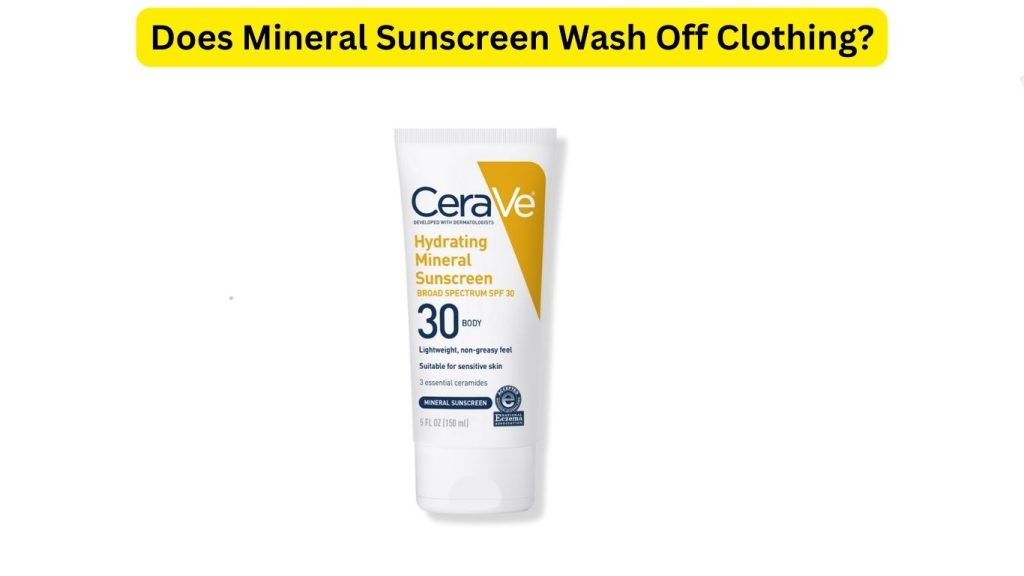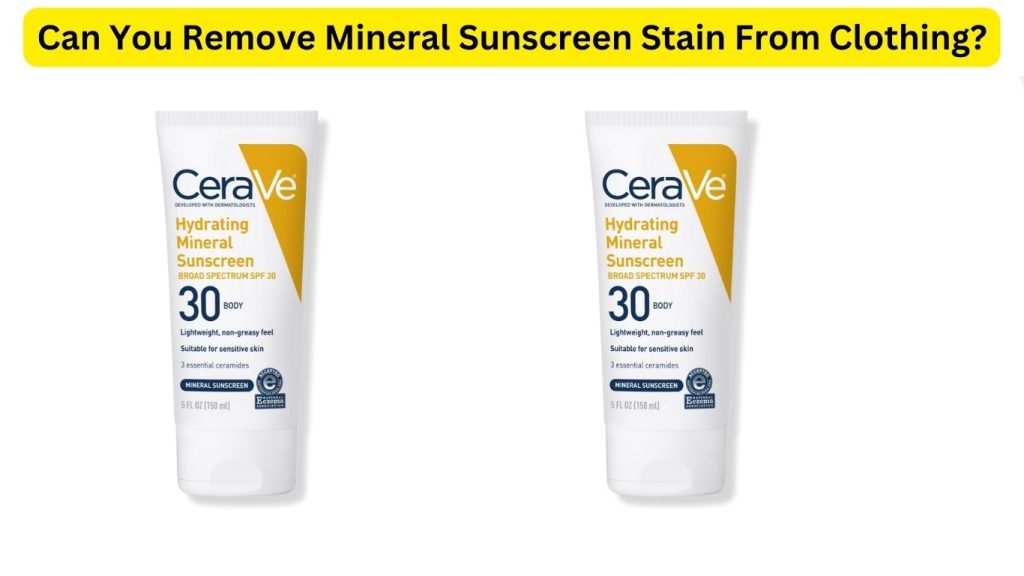Mineral sunscreen, revered for its natural sun protection properties, has gained popularity as a safer alternative to chemical sunscreens.
Composed of zinc oxide or titanium dioxide, it forms a physical barrier on the skin to deflect harmful UV rays. One common concern, however, is whether mineral sunscreen stains clothes.

This comprehensive guide delves into the factors contributing to potential staining, from formulation and application techniques to fabric types.
By understanding how mineral sunscreen interacts with clothing, you can make informed choices to prevent and mitigate any staining, ensuring both skin health and garment longevity.
Table of Contents
- Does Mineral Sunscreen Stain Clothes?
- Does Mineral Sunscreen Wash Off Clothing?
- Can You Remove Mineral Sunscreen Stain From Clothing?
- How To Get Mineral Sunscreen Stain Out Of Clothes: Different Ways
- How To Remove Yellow Sunscreen Stains From White Clothes?
- How To Prevent Mineral Sunscreen Stains From Clothes?
- Final words
Does Mineral Sunscreen Stain Clothes?
Yes, mineral sunscreen can potentially stain clothes. The active ingredients in mineral sunscreens, such as zinc oxide and titanium dioxide, can leave white marks or discolorations on fabric.
The risk of staining is influenced by factors like the formulation’s particle size, application method, and fabric type.
Non-nano formulations and allowing the sunscreen to absorb fully before dressing can reduce staining likelihood. Choosing clothing with a tight weave can also help minimize contact between sunscreen and fabric.
If staining occurs, prompt washing with suitable stain-removal methods is recommended. Overall, understanding these factors empowers you to enjoy the benefits of mineral sunscreen while safeguarding your clothes.
Does Mineral Sunscreen Wash Off Clothing?
Yes, mineral sunscreen can wash off clothing. The active ingredients, like zinc oxide and titanium dioxide, adhere to the skin and can transfer onto fabrics.

While mineral sunscreen is less likely to penetrate fabrics compared to chemical sunscreens, it can still leave residue or discoloration on clothing.
To minimize this, allow the sunscreen to fully absorb before dressing and opt for non-nano formulations. If staining occurs, prompt laundering using suitable stain-removal methods can often help mitigate the issue.
Being aware of these factors can help you enjoy the benefits of mineral sunscreen while maintaining the appearance of your clothing.
Can You Remove Mineral Sunscreen Stain From Clothing?
Yes, mineral sunscreen stains can often be removed from clothing with proper care and stain-removal techniques. Act quickly by blotting or scraping off excess sunscreen without spreading the stain.

Gently apply a pre-treatment stain remover, liquid laundry detergent, or dish soap to the stained area, and let it sit for a few minutes.
Then, wash the garment according to its care instructions using the warmest water suitable for the fabric. Check the stain before drying; if it’s not fully gone, repeat the process.
Avoid heat, as it can set the stain. Persistence and appropriate methods can often successfully remove mineral sunscreen stains.
How To Get Mineral Sunscreen Stain Out Of Clothes: Different Ways
Here are several methods for removing mineral sunscreen stains from clothes, along with step-by-step instructions:

Method 1: Dish Soap and Water
- Blot and Scrape: Gently blot the stained area with a clean cloth or paper towel to remove any excess sunscreen. Be careful not to spread the stain.
- Prepare Solution: Mix a solution of warm water and a mild dish soap. Avoid using colored or scented soaps, as they might worsen the stain.
- Apply Solution: Dip a clean cloth or sponge into the soapy solution and gently blot the stained area. Avoid rubbing, as this could push the stain deeper into the fabric.
- Let Sit: Allow the solution to sit on the stain for about 10-15 minutes. This helps break down the oils in the sunscreen.
- Rinse: Rinse the stained area with cool water to remove the soap and loosened sunscreen.
- Check Stain: Check if the stain is still visible. If it’s fading but not completely gone, you can repeat the process or try another method.
Method 2: Stain Remover
- Pre-Treat: Apply a pre-treatment stain remover to the stain, following the product’s instructions.
- Wait: Let the stain remover sit for the recommended amount of time, usually around 5-10 minutes.
- Wash: Wash the garment according to its care instructions using the warmest water suitable for the fabric. Check if the stain is gone before drying the clothes.
Method 3: Baking Soda Paste
- Mix Paste: Create a paste by mixing baking soda and water to form a thick consistency.
- Apply Paste: Spread the paste onto the stain, ensuring it covers the entire affected area.
- Let Sit: Allow the paste to dry on the stain. This might take a couple of hours.
- Brush Off: Once the paste is dry, gently brush off the dried mixture.
- Rinse and Wash: Rinse the stained area with cool water and then wash the garment as usual.
Remember to always follow the care instructions on the clothing label and perform a spot test on a hidden area before trying any stain-removal method.
It’s also crucial to avoid using hot water or applying heat to the stained area, as heat can set the stain permanently. With patience and the right techniques, mineral sunscreen stains can often be successfully removed from clothing.
How To Remove Yellow Sunscreen Stains From White Clothes?
Removing yellow sunscreen stains from white clothes can be a bit tricky, but there are a few methods you can try. Keep in mind that it’s important to act quickly before the stain sets in. Here’s a step-by-step guide:
Method 1: Vinegar and Baking Soda
- Blot the Stain: Carefully blot away any excess sunscreen using a clean paper towel or cloth. Be gentle to avoid spreading the stain.
- Mix Solution: Create a mixture of equal parts white vinegar and water.
- Pre-Treat: Gently apply the vinegar solution to the stained area. Let it sit for about 15 minutes. Vinegar can help break down the oils in the sunscreen.
- Scrub with Baking Soda: Create a paste by mixing baking soda with a little water. Gently scrub the stained area using the paste and a soft brush or toothbrush. Be careful not to scrub too hard to avoid damaging the fabric.
- Rinse and Launder: Rinse the treated area thoroughly with cold water to remove the vinegar and baking soda. Then, launder the garment as usual using a quality laundry detergent and the hottest water that is safe for the fabric.
Method 2: Dish Soap
- Blot and Scrape: Gently blot away any excess sunscreen using a paper towel. If there’s any solid residue, carefully scrape it off using a dull knife or spoon.
- Apply Dish Soap: Apply a small amount of liquid dish soap directly onto the stain. Gently work the soap into the fabric using your fingers or a soft brush.
- Let it Sit: Allow the dish soap to sit on the stain for about 10-15 minutes. Dish soap can help break down the oils in the sunscreen.
- Rinse and Launder: Rinse the treated area under cold running water to remove the soap. Then, wash the garment as usual in the washing machine using cold water and an appropriate laundry detergent.
Method 3: Hydrogen Peroxide
- Test for Colorfastness: Before using hydrogen peroxide, test a small, hidden area of the fabric to ensure it doesn’t cause any color fading or damage.
- Apply Hydrogen Peroxide: If the fabric is safe to use with hydrogen peroxide, dampen the stained area with cold water and then apply a small amount of hydrogen peroxide directly onto the stain.
- Blot and Rinse: Gently blot the stain with a clean cloth to help lift it. Rinse the treated area with cold water.
- Wash Normally: Launder the garment as usual in cold water with an appropriate laundry detergent.
Remember to always check the care instructions on your clothing before attempting any stain removal method, and perform a patch test in an inconspicuous area to ensure the method you choose doesn’t cause further damage to the fabric. Additionally, avoid using heat (hot water or high dryer settings) on the stain until it’s completely removed, as heat can set the stain.
How To Prevent Mineral Sunscreen Stains From Clothes?
Preventing mineral sunscreen stains from clothes involves a combination of proper application techniques and clothing choices. Here’s how you can minimize the risk of staining:
- Apply Sunscreen Carefully: Apply mineral sunscreen evenly to your skin and allow it to fully absorb before dressing. This reduces the chance of excess sunscreen transferring to your clothes.
- Choose Non-Nano Formulations: Opt for non-nano zinc oxide or titanium dioxide formulations. Non-nano particles are larger and less likely to penetrate fabrics, reducing the risk of staining.
- Wait Before Dressing: Give the sunscreen enough time to absorb into your skin before putting on clothing. This can help prevent the immediate transfer of the sunscreen to your clothes.
- Wear Tight-Weave Fabrics: Choose clothing with tight weaves, as this can create a barrier between your skin and the fabric, reducing the contact area for sunscreen transfer.
- Avoid Rubbing: Be cautious when wiping your skin with a towel after applying sunscreen, as rubbing can cause the sunscreen to transfer to your clothes.
- Use Sunscreen Stick or Powder: Consider using sunscreen sticks or powders for areas that might come into contact with clothing, as they can provide a more controlled application.
- Layer with Protective Clothing: Wear lightweight, long-sleeved shirts or cover-ups when possible, especially in areas where sunscreen transfer is more likely.
- Wash Hands After Application: Wash your hands thoroughly after applying sunscreen to prevent accidental transfer when touching your clothes.
- Carry a Towel: Have a clean cloth or towel on hand to gently pat your skin if you notice excess sunscreen before putting on clothing.
- Pre-Treat Stains Promptly: If a stain does occur, address it as soon as possible using appropriate stain-removal methods.
Remember that while these tips can help reduce the likelihood of mineral sunscreen stains, some staining might still occur. It’s a good practice to always check your clothes for stains after spending time in the sun and to take proactive steps to address any stains that do appear.
Read Next:
Final words
In conclusion, while mineral sunscreen is renowned for its skin-friendly attributes, its potential to stain clothes is a valid consideration. The staining risk is influenced by factors such as the sunscreen’s formulation, application method, and fabric type.
To minimize the likelihood of stains, opt for non-nano zinc oxide formulations, allow the sunscreen to fully absorb before dressing, and choose clothing with tight weaves.
In the event of accidental staining, prompt action can prevent permanent discoloration. By striking a balance between sun protection and clothing care, you can confidently enjoy the benefits of mineral sunscreen while preserving your wardrobe’s integrity.
